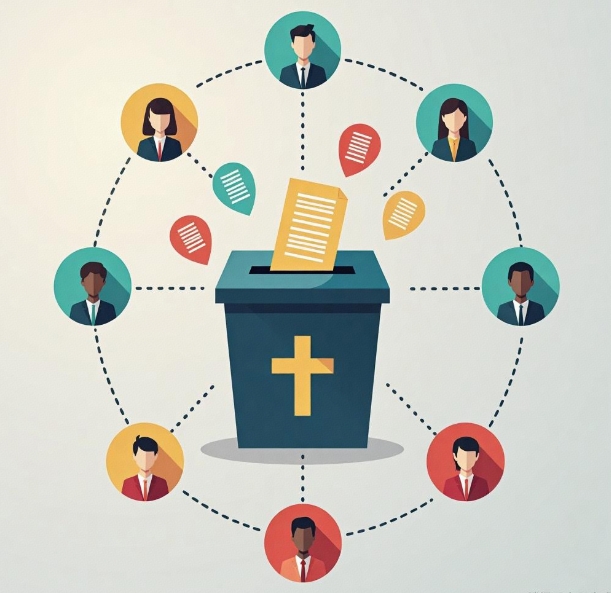Multi-party Participation and Co-governance Models in Blockchain Development
- latest articles
- 1.DApp Development & Customization: Merging Diverse Market Needs with User Experience 2.Analysis of the Core Technical System in DApp Project Development 3.How to achieve cross-chain interoperability in Web3 projects? 4.How does the tokenization of points reconstruct the e-commerce ecosystem? 5.How to Set and Track Data Metrics for a Points Mall? 6.What is DApp Development? Core Concepts and Technical Analysis 7.Inventory of commonly used Web3 development tools and usage tips 8.Development of a Distribution System Integrated with Social E-commerce 9.Six Key Steps for Businesses to Build a Points Mall System 10.What is DApp Development? A Comprehensive Guide from Concept to Implementation
- Popular Articles
- 1.Future Trends and Technology Predictions for APP Development in 2025 2.Analysis of the DeFi Ecosystem: How Developers Can Participate in Decentralized Finance Innovation 3.From Zero to One: How PI Mall Revolutionizes the Traditional E-commerce Model 4.DAPP Development | Best Practices for Professional Customization and Rapid Launch 5.Recommended by the Web3 developer community: the most noteworthy forums and resources 6.From Cloud Computing to Computing Power Leasing: Building a Flexible and Scalable Computing Resource Platform 7.How to Develop a Successful Douyin Mini Program: Technical Architecture and Best Practices 8.Shared Bike System APP: The Convenient Choice in the Era of Smart Travel 9.How to Create a Successful Dating App: From Needs Analysis to User Experience Design 10.From Design to Development: The Complete Process of Bringing an APP Idea to Life
Blockchain technology, as a decentralized distributed ledger technology, has demonstrated immense potential across many industries. From finance to supply chain management, and from digital identity authentication to intellectual property protection, blockchain technology is transforming our digital world. One of its most significant features is decentralization, which means multiple participants can collectively maintain the security and transparency of the network without the need for a trusted intermediary. In the process of blockchain development and application, the multi-party participation and co-governance model, as a core concept, has gradually become a key factor driving the development of the blockchain ecosystem.
This article will delve into the multi-party participation and co-governance model in blockchain development, analyzing its components, advantages, challenges, and application cases, and explore how well-designed co-governance mechanisms can promote the healthy development of blockchain technology.
I. Overview of the Multi-Party Participation and Co-Governance Model in Blockchain
1.1 Multi-Party Participation
Multi-party participation refers to the involvement of various stakeholders in the blockchain network beyond the core developers, including miners, validator nodes, users, governors, developer communities, etc. The collective participation of these different roles forms the foundation of the blockchain ecosystem.
Developers: Responsible for the development, maintenance, and updates of the blockchain protocol. Developers typically come from diverse backgrounds, including open-source communities, technology companies, academic institutions, etc.
Miners/Validator Nodes: These participants maintain the security of the blockchain network by providing computational power, ensuring the validity of transactions and recording them onto the blockchain. Miners validate blocks through consensus mechanisms such as Proof of Work (PoW) or Proof of Stake (PoS).
Users: The end-users of the blockchain network, who participate directly or indirectly through smart contracts, DApps (decentralized applications), etc.
Governors: Some blockchain networks have specialized governance mechanisms where governors are responsible for deciding the direction of protocol changes, upgrades, or forks.
1.2 Co-Governance Model
The co-governance model refers to the mechanism within the blockchain network where multiple parties collectively participate in decision-making, management, and resource allocation. Unlike traditional centralized management models, blockchain's co-governance model encourages collaboration among multiple participants in a decentralized manner to maintain the stability and development of the network.
In the co-governance model of blockchain, the following mechanisms typically exist:
On-Chain Governance: On-chain governance executes governance decisions through smart contracts or the protocol itself. For example, some blockchain networks use voting mechanisms to decide on protocol updates.
Off-Chain Governance: Off-chain governance typically refers to decision-making through external governance organizations or communities. Although the final decisions affect the blockchain network, the execution process may occur outside the blockchain.
Decentralized Autonomous Organization (DAO): A DAO is an organizational form based on blockchain technology that places all organizational decisions, operations, and resource allocation under the control of blockchain smart contracts, governed by participants through voting mechanisms.
1.3 The Relationship Between Multi-Party Participation and the Co-Governance Model
Multi-party participation and the co-governance model are closely related. The decentralized nature of blockchain requires the collaboration and governance of multiple participants, and the co-governance model provides a framework to ensure these participants can engage fairly and justly in the blockchain's decision-making process. In other words, the co-governance model can only be effectively implemented and developed on the basis of multi-party participation.
II. Advantages of the Multi-Party Participation and Co-Governance Model
2.1 Enhancing the Security and Decentralization of the Blockchain Network
Multi-party participation can effectively enhance the security of the blockchain network. In traditional centralized systems, a single management or operational entity can become a target for attacks, leading to system failure or data breaches. However, in a blockchain network, because multiple participants collectively maintain the network's operation, attackers must control the majority of nodes to effectively tamper with the data on the blockchain, significantly increasing the difficulty of attacks.
Additionally, multi-party participation ensures the decentralization of the blockchain network, preventing power from being overly concentrated in a single entity and ensuring a balance of interests among all parties.
2.2 Improving the Democracy and Transparency of Decision-Making
The co-governance model, through its decentralized decision-making mechanism, allows every participant to have a voice in the evolution of the protocol. This decentralized approach to decision-making enhances democracy, and because all decision-making processes are open and transparent, every participant can see the basis and outcomes of decisions, thereby increasing trust in the entire network.
2.3 Promoting the Sustainable Development of Blockchain Technology
The sustainable development of blockchain networks relies on the balance and collaboration of various interests. The co-governance model provides a fair platform for all parties, allowing different stakeholders to discuss and decide on the development direction of the blockchain network collectively. Whether it's protocol upgrades or resource allocation, everything can be carried out in a decentralized, open, and transparent environment, thereby promoting the long-term development of blockchain technology.
III. Challenges Faced by the Multi-Party Participation and Co-Governance Model
Although the multi-party participation and co-governance model offer many advantages, they also face some challenges in practical application:
3.1 Coordination Efficiency Issues
Multi-party participation means that decision-making must consider the opinions of more stakeholders, which can complicate and prolong the decision-making process. Especially in situations requiring urgent decisions, coordinating the opinions of different interest groups may reduce decision-making efficiency.
3.2 Governance Mechanism Design Issues
Effective governance mechanisms are key to realizing the blockchain co-governance model. However, designing governance mechanisms is often a highly complex task. Balancing the power of various parties, ensuring fairness and justice, and avoiding the risk of centralization remain issues that require continuous exploration.
3.3 Balancing Incentives and Participation
Blockchain network participants consist of various roles, each with different motivations and expectations. Designing reasonable incentive mechanisms to encourage active participation in governance by different roles, while preventing any single party from gaining excessive benefits, is another major challenge for the blockchain co-governance model.
3.4 Legal and Compliance Issues
The decentralized nature of blockchain technology often transcends the jurisdiction of traditional legal systems. Achieving effective global regulation and compliance is also a practical challenge faced by the multi-party participation and co-governance model.
IV. Application Cases of the Multi-Party Participation and Co-Governance Model in Blockchain Development
4.1 Ethereum and DAO
As one of the world's most famous smart contract platforms, Ethereum's blockchain network governance model has strong decentralized characteristics. Ethereum's development community involves global developers and users who participate collectively, proposing network changes and improvements through the proposal mechanism (EIP). Additionally, Ethereum's DAO (Decentralized Autonomous Organization) model provides a practical case for co-governance. DAOs automate decision-making through smart contracts, with all governance processes conducted via open and transparent voting mechanisms.
4.2 Polkadot
Polkadot is a project aimed at achieving blockchain interoperability, adopting a multi-party participation and co-governance model. In Polkadot's network structure, all participants (including validator nodes, developers, governors, etc.) can decide on the network's upgrade direction and resource allocation through voting mechanisms. Polkadot's co-governance model emphasizes balancing the power of different interest groups to avoid excessive intervention by any single party.
4.3 Tezos
Tezos is a blockchain platform that supports on-chain governance. The unique aspect of Tezos is that its protocol upgrade process is entirely decided by network participants through voting, without the need for hard forks. This model allows developers, users, and governors to directly participate in network improvements, ensuring the blockchain protocol can continuously adapt to new demands.
V. Conclusion
The development of blockchain technology relies on the support of the multi-party participation and co-governance model. Through well-designed co-governance mechanisms, the decentralization, security, transparency, and sustainable development of blockchain networks can be effectively promoted. However, in practice, we also need to address issues such as coordination efficiency, governance mechanisms, incentive balance, and legal compliance. As blockchain technology continues to mature and application scenarios expand, the multi-party participation and co-governance model will play an increasingly important role in the future blockchain ecosystem, driving blockchain technology toward a more open and prosperous future.
-

How to achieve cross-chain interoperability in Web3 projects?
With the continuous development of WEB3 technology, Web3 has gradually become an···
-

Inventory of commonly used Web3 development tools and usage tips
With the continuous development of blockchain technology, Web3 has become a hot ···
-

Web3 development trend prediction: analysis of future technology directions and application scenarios
With the gradual development of blockchain technology, the concept of Web3 has m···

 Blockchain
Blockchain












